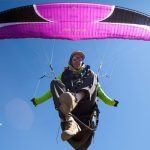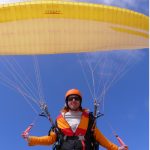Paragliding rules and regulation for safety
Learning the rules and regulations is an important part of your training. Thoroughly understanding them will make the activity safer, allow you to anticipate and avoid potential hazards and gain precious time in case you have to make a quick decision.
They'll determine your course of action depending on the location of your flight, the presence of other aircraft in the same airspace or weather conditions and other criteria that we're going to look at.
The rules we'll cover in this chapter are internationally accepted and enforced in most countries. We've done our best to point out exemptions as wrong. However, you should always keep in mind that rules may differ from one country to another. Before leaving to fly abroad, find out about the regulations of the country you're visiting and remember
to respect local laws. You'll usually find them on the website of the National Federation.
Right of way and priority in flight for paragliders
The increase in air traffic over the years has led civil aviation authorities to create aircraft categories and rules to establish priority among them: hot air balloons have priority over all others, they move slowly and have a lot of inertia. All other aircraft must yield the right-of-way to them. Then comes to sailplanes, paragliders and hand gliders. They all belong to the same category. Motorized aircraft such as helicopters, or airplanes have the least priority in terms of right-of-way.
As we've just seen, each category of aircraft has a different degree of priority. Sailplanes,
hang gliders and paragliders all belong to the same category. In reality, questions of right-of-way will mostly arise with other paragliders or with hang gliders flying in the same airspace, as sailplanes or private airplanes is rare.
Anti-collision rules in flight for paragliders
Let's go over the rules of priority. That prevent paragliders from colliding.
The prime rule is the following: it's the pilot's responsibility to take all possible measures to avoid a collision with any other aircraft. Try to maintain a safe distance from the other aircraft.
Two paragliders are approaching head-on
First situation: two paragliders are approaching head-on with a risk of collision. In this case both aircraft shall alter course to the right.
In case of hill or Ridge soaring this rule is modified: two paragliders are approaching head-on when rich soaring. The pilot with the ridge on the Left should move out so that the other can maintain course without having to turn into or over the ridge.
Two paragliders have converging courses
When two aircraft of the same classification converge at approximately the same altitude, the one with the other on its right shall give way; on the right is in the right.
In flight, if you come across the situation like this acts as quickly as possible. It's pointless to wait till the last minute before reacting moving out of the way and scaring both yourself
and the pilot.
Overtaking another paraglider
Because each wing has its own technical specifications, your paraglider may fly faster than others. Passing someone is permitted. Internationally, passing is typically done on the right. The aircraft being passed has the right of way, except in Italy where the glider
overtaking has priority but must allow enough safety clearance. The glider being overtaken gives way avoiding any change in direction. That might interfere with the overtaking paragliders passed.
Also in England and in Italy in free space away from a hill paragliders can pass on the left as well as the right.
When ridge-soaring, a paraglider overtaking another glider that is flying in the same direction should pass between the ridge and the glider being overtaken. If you're overtaking the pilot and there is no room to pass, just turn back.
Turn direction in a thermal with another paraglider in
When thermalling, the first pilot to enter a thermal establishes the required turning direction in that thermal; all paragliders joining shall circle in the same direction as any other gliders already established in the lift.
Know the flight rules for safety
In order to keep the sky safe and accident-free you must know these rules. Nevertheless, be flexible when flying, don't rely on others to always respect your right of way faced
with a disrespectful or inattentive pilot, you're better off abandoning your priority and changing your heading.
Anticipate these situations early and react decisively so that other pilots flying around you know what your intentions are.
This post is a transcription of the video "Learn to Fly" (Kitchen Productions)

















